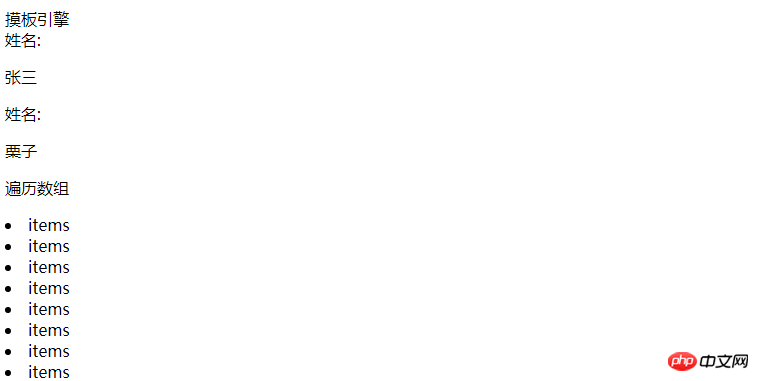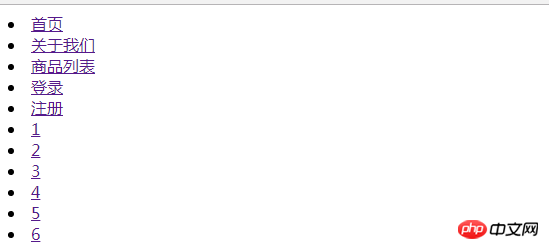
This time I will show you how to use node combined with swig to render the template. What are the precautions for using node combined with swig to render the template? The following is a practical case, let's take a look.
First of all, of course, we use the express framework to build services on the node background.var express = require('express');
var server = express();
server.listen(8080,'localhost',(req,res)=>{
console.log('服务器启动...');
})npm install swig -s
//配置摸板引擎
var swig = require('swig');
//参数1,摸板引擎的名称,固定字段
//参数2,摸板引擎的方法
server.engine('html',swig.renderFile);
//摸板引擎存放目录的关键字,固定字段
//实际存在的目录,html文件就在html文件夹下面
server.set('views',dirname+'/html');
//注册摸板引擎,固定字段
server.set('view engine','html');
//关闭swig缓存,缓存的目的也是提高node服务器的响应速度
swig.setDefaults({cache:false});server.get('/',(req,res)=>{
//render方法只有在使用摸板引擎之后才会生效,其中 参数1是需要渲染的摸板名称,参数2就是需要渲染到页面的一些参数
res.render('temp',{
name:'张三',
user:{
name:'栗子',
age:18
},
lists:['item1','item2','item3','item4','item5',
'item6','item7','item8','item9','item10','item11','item12',
'item13','item14','item15','item16','item17','item18','item19',
'item20','item21','item22','item23','item24','item25','item26']
});
})<!DOCTYPE html>
<html lang="en">
<head>
<meta charset="UTF-8">
<meta name="viewport" content="width=device-width, initial-scale=1.0">
<meta http-equiv="X-UA-Compatible" content="ie=edge">
<title>Document</title>
</head>
<body>
<p>摸板引擎</p>
<!-- {{}} 插值表达式-->
姓名:<p>{{name}}</p>
{% if user.name == '栗子' && user.age == '18'%}
姓名:<p>栗子</p>
{% elseif user.name == '张三'%}
<p>张三</p>
{% endif %}
<p>遍历数组</p>
{% for items in lists%}
<li>items</li>
{% endfor %}
<!-- 页面上面设置数据 -->
{% set arr = [1,2,3,4,5]%}
<p>{{arr.length}}</p>
<!-- 如何引入页面-->
{% include './common.html' %}
</body>
</html>
<header>
<title>node</title>
<!-- css占位符主要用来显示其他页面的个性化的css文件,例如home.css about.css -->
{% block css%}
{% endblock %}
<link rel="stylesheet" href="/static/css/layout.css" rel="external nofollow" >
</header>
<!-- 所以页面公共的导航栏 -->
<nav>
<li><a href="">首页</a></li>
<li><a href="">关于我们</a></li>
<li><a href="">商品列表</a></li>
<li><a href="">登录</a></li>
<li><a href="">注册</a></li>
</nav>
<!-- content占位符主要用来显示其他页面的个性化的内容显示,不同的页面有不同的显示方式 -->
{% block content%}
{% endblock %}
<!-- js占位符主要用来显示其他页面的个性化的js文件,例如home.js about.js -->
{% block js%}
{% endblock %}
<script src="/static/js/layout.js"></script><!-- 继承所有页面公共的页面模块layout.html -->
{% extends './layout.html'%}
{% block css %}
<link rel="stylesheet" href="/static/css/home.css" rel="external nofollow" >
{% endblock %}
{% block content %}
<li><a href="">1</a></li>
<li><a href="">2</a></li>
<li><a href="">3</a></li>
<li><a href="">4</a></li>
<li><a href="">5</a></li>
<li><a href="">6</a></li>
{% endblock %}
{% block js %}
<script src="/static/js/home.js"></script>
{% endblock %}server.get('/',(req,res)=>{
res.render('www/home',{});
})
How to use JS to merge multiple arrays to recalculate
jquery dynamically adds click event steps Detailed explanation
The above is the detailed content of How to use node combined with swig rendering template. For more information, please follow other related articles on the PHP Chinese website!




